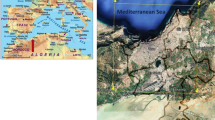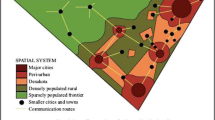Abstract
The study aims to investigate the urban change in the West Bank between the years 1997 to 2016, under complicated geopolitical conditions. High-resolution aerial photographs (1.25 m and 0.1 m) and moderate-resolution satellite imagery (30 m resolution Landsat data) were used in this study. The results of the study showed that the Palestinians suffer from serious limitations imposed by the Israeli occupation due to the urban expansion, especially in the so-called area C, which represents 61% of the West Bank. The Israeli occupation controls this area. On the other hand, the Israeli occupation provides an opportunity to the Israeli settlers to build more houses and buildings for various purposes. The study also shows that most of the Palestinian urban expansion comes at the expense of agricultural lands. The study recommends that the international community has to place more pressure on Israel to give the Palestinians their freedom to plan for their future, and use their lands freely.




Similar content being viewed by others
References
Abdelhamid, A. M. (2005). Monitoring human intervention in the coastal margin of western delta: Analysis of remote sensing data (1984–2004). Geographical Letters, Kuwait Geographical Society, No. 300.
Abu Bakr, A., et al. (2015). Urban expansion assessment by using remotely sensed data and the relative Shannon entropy model in GIS: A case study of Tripoli, Libya. Theoretical and Empirical Research in Urban Management,10, 55–71.
Al-Mazroui, M., et al. (2017). Application of landsat data for urban growth monitoring in Jeddah. Springer Earth Systems and Environment,1, 25.
Al-Tuwaijri, H. A. (2018). Urban expansion of the city of Riyadh (1987–2017) using remote sensing and GIS techniques. Journal of Architecture of Planning, 30(2), 195–213.
Btselem. (2014). Publications: 47 years of temporary occupation. Retrived June 2019 from https://www.btselem.org/publications/summaries/47_year_long_temporary_occupatin. www.earthexplorer.usgs.gov
Bushnaq, B. (2013). Administrative organization of districts in Palestine. Palestine Economic Policy Research Institute (MAS), Series of Law reports 34, Ramallah, Palestine.
Ennab, W. (1979). Economic geography of the west bank. Unpublished Master Thesis, Cairo University, Egypt.
Fadda, E., et al. (2016). Spatial analysis of population growth and urbanization in the Governorate of Muscat using remote sensing and GIS. International Journal of Planning, Urban and Sustainable Development. Researchgate.net. Publication/303312288. The 9th international conference of geomatics in the Middle East and North Africa.
Ghodieh, A. (2000). An evaluation of satellite remote sensing for crop area estimation of the West Bank, Palestine. Unpublished Doctoral Thesis, Durham University, UK.
Google Earth. earth.google.com/web/.
Kamel, Sh. (2013). Urban growth on agricultural lands of the cities of Al-Fayoum Governorate: A study in urban geography. Unpublished Ph.D. Thesis, Cairo University, Egypt.
Kittaneh, M. T. (2009). Study of urban encroachment impact on environmental and agricultural land in Ramallah and Al-Bireh cities using geographic information systems (GIS) and remote sensing (RS) techniques. Unpublished MA Thesis, Birzeit University, Palestine.
Lakshmi, K. N., et al. (2011). Forecasting urban growth based on GIS, RS, and SLEUTH model in Pune metropolitan area. International Journal of Geomatics and Geosciences,2(2), 568.
Mohammad, I. A. (2014) Urban crawling on agricultural land in the Floodplain of Qina Center (1941–2013). Using remote sensing & GIS. Arab geographic journal, series of geographic research papers.
Mohapatra, S. N. (2014). Rapid urban expansion and its implications on geomorphology, a remote sensing and GIS based study. London: Hindawi Publishing Corporation.
Ocha. (2015). Humanitarian bulletin, monthly report. http://data.ochaopt.org/documents/ocha_opt_the_humanitarian_monitor_2014_07_01_english.pdf.
Palestinian Ministry of Local Government. (2019). Retrived June 2019 from http://geomolg.ps/L5/Index.html?configBase=http://geomolg.ps/Geocortex/Essentials/REST/sites/A3/viewers/V1/virtualdirectory/Resources/Config/Default.
Peace Now. (2019). Maps: Middle east and wars on terror. Retrived June 2019 from https://www.pinterest.com/gmcdowel/maps-middle-east-and-wars-on-terror/.
Roberts, A. (1990). Prolonged military occupation: The Israeli-occupied territories since 1967. The American Journal of International Law, 84(1), 44–103.
Shoukry, N. A. (2004). Using remote sensing and GIS for monitoring settlement growth expansion in the eastern part of the Nile Delta Governorates in Egypt (1975–1998). Unpublished Ph.D. thesis, University of Utah.
Staff, T., & Majid, J. (2017). Israeli plan to double size of Qalqilia Enrages settler leaders. Retrived June 2019 from https://www.timesofisrael.com/israeli-plan-to-double-size-of-qalqilya-enrages-settler-leaders/.
Ta’ani, A., (2014). A remote sensing and GIS evaluation of urban expansion in Al-Hufof. Saudi Arabia. An-Najah Journal for Studies (Human Sciences), 28(8), 1813–1836.
Tafakje, K. (2001). Geographic and demographic settlement and its dangers on the issue of Jerusalem. Ro’ya Magazine, Issue 10.
The Guardian. (2012). Population of Jewish settlements in West Bank up 15,000 in a year. Retrived June 2019 from https://www.theguardian.com/world/2012/jul/26/jewish-population-west-bank-up.
The Palestinian Initiative for the Promotion of Global Dialogue and Democracy—MIFTAH. (2018). Settlement Factsheet. Retrived June 2019 from http://www.miftah.org/Doc/Factsheets/Miftah/English/Settlements_Factsheet_V2_24October2018.pdf.
The Palestinian meteorological Department. (2018). Climate statistics. Retrived June 2019 from http://www.pmd.ps/loadElementMean.do.
The Palestinian National Information Centre (WAFA). (2008). Building in area C according to Oslo Accord. Retrived June 2019 from http://info.wafa.ps/ar_page.aspx?id=5178.
United Nations. (2014). Office for the Coordination of Humanitarian Affairs occupied Palestinian territory. Area C of the West Bank: Key Humanitarian Concerns.
UN Security Council Resolution 465. Retrived June 2019 from http://www.ynet.co.il/articles/0,7340,L-3496637,00.html.
Acknowledgements
This work was supported by the Deanship of the Scientific Research at An-Najah National University in Nablus, Palestine (Project ANNU17185O003).
Author information
Authors and Affiliations
Corresponding author
Additional information
Publisher's Note
Springer Nature remains neutral with regard to jurisdictional claims in published maps and institutional affiliations.
About this article
Cite this article
Ghodieh, A. Urban Built-Up Area Estimation and Change Detection of the Occupied West Bank, Palestine, Using Multi-temporal Aerial Photographs and Satellite Images. J Indian Soc Remote Sens 48, 235–247 (2020). https://doi.org/10.1007/s12524-019-01073-8
Received:
Accepted:
Published:
Issue Date:
DOI: https://doi.org/10.1007/s12524-019-01073-8




